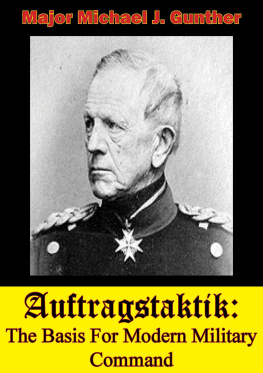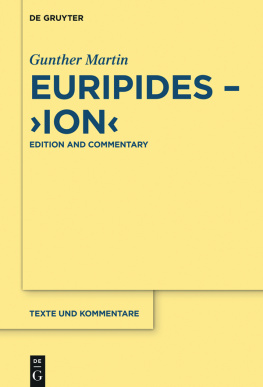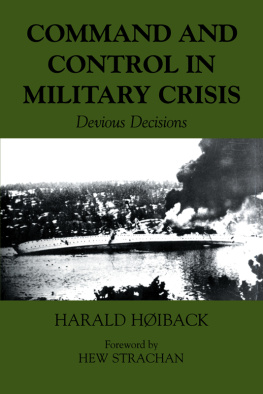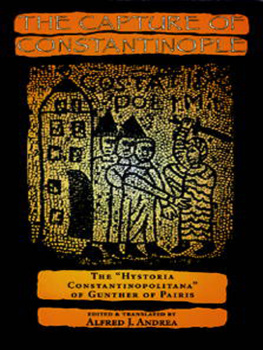This edition is published by PICKLE PARTNERS PUBLISHINGwww.picklepartnerspublishing.com
To join our mailing list for new titles or for issues with our books picklepublishing@gmail.com
Or on Facebook
Text originally published in 2012 under the same title.
Pickle Partners Publishing 2015, all rights reserved. No part of this publication may be reproduced, stored in a retrieval system or transmitted by any means, electrical, mechanical or otherwise without the written permission of the copyright holder.
Publishers Note
Although in most cases we have retained the Authors original spelling and grammar to authentically reproduce the work of the Author and the original intent of such material, some additional notes and clarifications have been added for the modern readers benefit.
We have also made every effort to include all maps and illustrations of the original edition the limitations of formatting do not allow of including larger maps, we will upload as many of these maps as possible
AUFTRAGSTAKTIK: THE BASIS FOR MODERN MILITARY COMMAND?
By
Major Michael John Gunther, Army
TABLE OF CONTENTS
Contents
ABSTRACT
Gen. Helmuth von Moltke, the Chief of the Prussian General Staff during the Franco-Prussian War, defined Auftragstaktik as the actions a subordinate took in the absence of orders that supported the senior commanders intent. The use of mission tactics allowed subordinate commanders like Crown Prince Frederick Karl, Gen. Konstantin von Alvensleben, and Gen. Karl von Steinmetz to interpret how best to achieve the commanders intent based upon their understanding of the tactical situation. The Prussian use of decentralized command during the Franco-Prussian War acknowledged the risk inherent in this system of command. Despite what modern military theorists often write, Auftragstaktik and mission command are not synonymous terms. Most authors ignore the historical environment that the Prussian military operated in during the Franco-Prussian War. This study examines the influence of the Prussian concept of Auftragstaktik on the modern US Army notion of mission command as defined within the published doctrine. It utilizes archival records and pertinent published histories from the August 1870 battles on the Franco-Prussian frontier, Moltkes 1869 Instructions for Large Unit Commanders , as well as writings from the 1980s to describe the influence of Prussian system on the modern concept of mission command.
ACRONYMS
ADPArmy Doctrine Pamphlet
ADRPArmy Doctrine Reference Publication
Brig. Gen.Brigadier General
Capt.Captain
Col.Colonel
FMField Manual
Gen.General
Lt.Lieutenant
Lt. Col.Lieutenant Colonel
Lt. Gen.Lieutenant General
Maj.Major
Maj. Gen.Major General
MMWMoltkes Militrische Werke (Moltkes Military Works)
St.Saint
ILLUSTRATIONS
Figure 1.Unified Land Operations
Figure 2.The Mission Command Philosophy
Figure 3.The Operations Process
Figure 4.Moltkes Plan on 1 August 1870
Figure 5.The Battle of Weissenburg
Figure 6.The Battle of Spicheren, Situation at 1700
Figure 7.Moltke Changes the Direction of March, 14-16 August 1870
Figure 8.The Battle of Mars-la-Tour
Figure 9.The Battle of Gravelotte, Situation at 0900
Figure 10.The Battle of Gravelotte, Situation at 2000
Auftragstaktik : The Basis for Modern Military Command?
Gen. Helmuth von Moltke, Chief of the German General Staff, allowed subordinate leaders independence to interpret the situation and execute actions that fulfilled the commanders intent rather than the letter of the order.
The Prussians, and later the Germans, developed this system of command during the mid-nineteenth century Wars of German Unification. In August 1870, the Prussians defeated Louis-Napoleon Bonapartes Army of the Rhine in a series of battles that eventually contributed to the fall of the French Second Empire. Although French units had several material advantages over the Prussians, their commanders failed to notice a fundamental change in how the Prussians commanded and controlled their units after the 1866 Austro-Prussian War. Prussian commanders had instituted decentralized command and control in the pursuit of a singular military objective. This method of command often resulted in units entering the battle in a haphazard method during the wars early campaigns; however, they ultimately won the battles.
Although the modern German Bundeswehr continues to use Moltkes system of command, other armies have been reluctant to adopt a decentralized approach. The Germans used this method of task-oriented, decentralized command through the first half of World War II; German doctrine used the term Auftragstaktik to describe it.
Gen. Helmuth von Moltke, Chief of the Prussian General Staff during the Franco-Prussian War, defined Auftragstaktik as the actions a subordinate took in the absence of orders that supported the senior commanders intent. Commanders that failed were rarely relieved as long as their understanding of the directives was sound and their execution vigorous.
Few modern works address the Franco-Prussian War and the incorporation of Auftragstaktik by the German armies during that conflict. Two modern histories of the Franco-Prussian War typically dominate the academic field. The first, Sir Michael Howards Franco-Prussian War is generally considered by historians to be the definitive history of the conflict. The second, Geoffreys Wawros The Franco-Prussian War, largely compliments Howards analysis. However, his volume adds a more definitive narrative concerning the Prussian actions to defeat a number of smaller French armies during the siege of Paris. Wawro is also the only author specifically to address the use of Auftragstaktik in his analysis of the Prussian actions. In addition to these contemporary accounts, the German General Staffs five-volume official records, The Franco-German War, 1870-1871 , provides in depth accounts of the battles from the German perspective. Conversely, a number of modern authors have addressed Auftragstaktik and its adoption as doctrine by the US Army, but no single volume or article dominates the field. In The German Way of War, Robert Citino offered some analysis of Auftragstaktik s evolution in the German Army and in his conclusion offers analysis of the problems associated with the US Armys adoption of mission tactics in modern doctrine.
Despite the common belief in modern US military doctrine, Auftragstaktik and mission command are not synonymous terms. Most modern authors ignore the historical environment in which the Prussian army operated during the Franco-Prussian War. Military commanders belonged to the nobility or Junker class because the king sought to link those classes with the national government. In other words, the monarch believed that he could trust these officers because they had the most to lose if the government collapsed in a revolution or war. However, their chiefs of staff and primary advisors rarely came from the same privileged background. Indeed, because of their status, commanders had the right to act independently of Moltkes instructions while on campaign. Further highlighting the social differences within the Prussian army, individual soldiers came almost exclusively from the lower classes because they were subject to universal service. Generally, they lacked upward mobility through promotion to the officer ranks. In theory, every soldier in the US Army has the potential to move into the officer ranks, command units, and make attain the rank of general. Another important contextual difference between the Prussian army and the modern US Army is the amount of information instantly available to the commander on the battlefield through the use of radios, computers, drones, and satellite imagery. It is much more difficult for a modern subordinate commander to act independently of his higher commander by taking advantage of the time to transmit information between headquarters.












